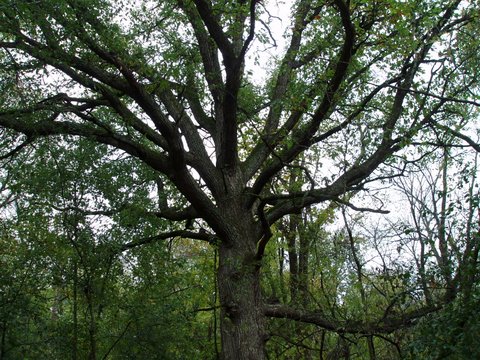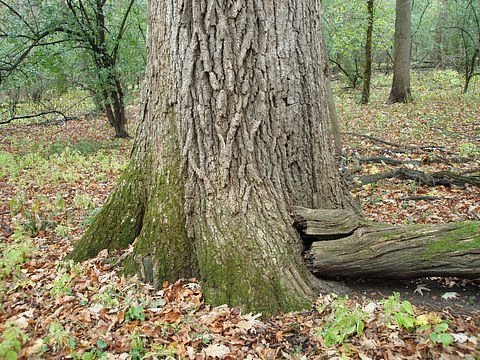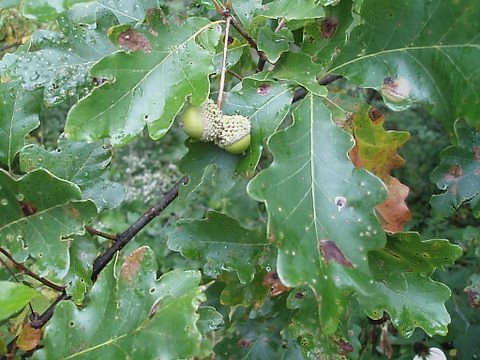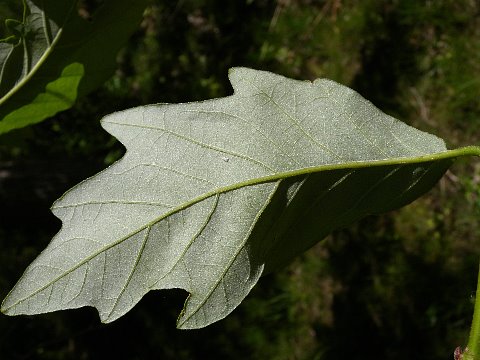
Swamp White Oak is monoecious, producing separate male (staminate) and female (pistillate) flowers on the same tree. The male flowers are produced along drooping catkins about 2-4" long; the male flowers are sparsely distributed along these catkins in small clusters. Each male flower (about 1/8" or 3 mm. in length) consists of several stamens that are embedded within hairy floral bracts. The female flowers are produced from the axils of leaves in clusters of 2-4. Each female flower (about 1/8" or 3 mm. in length) consists of an ovary with usually 3 stigmata; it is embedded within an involucre consisting of hairy floral scales. The blooming period occurs from mid- to late-spring and lasts about 1-2 weeks. The flowers are cross-pollinated by wind. Afterwards, fertile female flowers develop into acorns that become ¾-1" long and ½-¾" across at maturity during the autumn of the same year. Usually, only 1-2 acorns develop near the tip of a long peduncle about ½-4" long, while the pedicel of each acorn is very short (less than 1/8" or 3 mm. long). The cup of a mature acorn is tan-colored or light gray, while its body is brown; the cup extends to about one-third of the length of an acorn. The scales of the cup are somewhat recurved and pointed, rather than appressed together. The white acorn meat is mildly bitter. The woody root system is shallow to moderately deep and widely spreading. During the autumn, the deciduous leaves become brownish yellow, sometimes with patches of orange and red.

Cultivation: The preference is full sun, wet to mesic conditions, and soil containing some combination of loam, clay, silt, or sand. Soil pH should be non-alkaline. Both compaction of the soil and temporary flooded conditions are tolerated. Individual trees can produce acorns in 20-30 years and they may live 300-350 years. Mature acorns will germinate shortly after they have been placed in moist ground.
Range & Habitat: The native Swamp White Oak is occasional in most areas of Illinois, except in the NW section of the state, where it is rare or absent (see Distribution Map). Habitats include floodplain woodlands, edges of swamps, borders of streams, sloughs, poorly drained upland flats, and edges of vernal pools in wooded areas. Swamp White Oak is found with miscellaneous deciduous trees in poorly drained areas, including Green Ash, American Elm, Red Maple, Silver Maple, American Sycamore, Eastern Cottonwood, Pin Oak, Bur Oak, Shellbark Hickory, Sweet Gum, Black Gum, and Black Willow. Sometimes Swamp White Oak is cultivated as a landscape tree in parks and residential areas.

Faunal Associations: The value of Swamp White Oak and other oaks (Quercus spp.) to wildlife is high. The following leafhoppers prefer Swamp White Oak as a host plant: Eratoneura accola, Eratoneura fergusoni, and Eratoneura mirifica. Other leafhoppers that feed on this tree include Eratoneura carmini, Eratoneura externa, and Eratoneura solita. Other insects feeders include the aphids Myzocallis punctatus and Myzocallis walshii, and the treehoppers Atymna helena and Cyrtolobus maculifrontis. The larvae of a large number of beetles bore through the wood or bark of this and other oaks. These species include Eucrada humeralis (Anobiid Beetle sp.), Arrhenodes minuta (Oak Timberworm), Aneflomorpha subpubescens (Oak Stem Borer), Goes debilis (Oak Branch Pruner), and Oberea gracilis (Oak Sprout Pruner); see the Wood-Boring Beetle Table for a more complete list of these species. Other insect feeders include several leaf beetles (Metachroma spp., Pachybrachis spp., etc.), Brachys ovatus (Oak Leaf Miner) and other Brachys spp., larvae of the weevils Attelabus bipustulatus and Homoeolabus analis, the plant bugs Ceratocapsus modestus and Plagiognathus guttulosus, Corythucha arcuata (Oak Lace Bug), and the larvae of various gall wasps (Cynipidae). The caterpillars of Hairstreak butterflies, Duskywing skippers, and numerous moths also feed on the foliage and other parts of oaks (see Lepidoptera Table). These various insects are an attractive source of food for woodpeckers, warblers, flycatchers, and other insectivorous birds. Acorns are an important source of food for many birds and mammals. Acorn-eating birds include the Wood Duck, Wild Turkey, Ruffed Grouse, Ring-Necked Pheasant, Monk Parakeet, White-Breasted Nuthatch, Blue Jay, Common Grackle, Rusty Blackbird, Brown Thrasher, Red-Headed Woodpecker, and Red-Bellied Woodpecker. Acorns are also eaten by the Black Bear, Raccoon, White-Tailed Deer, White-Footed Mouse, and various tree squirrels. There is even a record of a turtle, Trionyx spiniferus (Spiny Softshell), eating acorns (Ernst et al., 1994).

Photographic Location: Photographs of the tree silhouette, tree trunk, and leafy twigs with acorns were taken by Paul Showers (Copyright © 2011) in NE Illinois. The photograph of the leaf undersides was taken by John Hilty near a stream at Meadowbrook Park in Urbana, Illinois.
Comments: Where their ranges overlap, this oak sometimes hybridizes with the Bur Oak (Quercus macrocarpa) and Basket Oak (Quercus michauxii) – all of these oaks prefer bottomland habitats. Swamp White Oak can be distinguished from White Oak (Quercus alba) and Bur Oak by the more shallow lobes of its leaves and their whitened undersides. It differs from Basket Oak by having fewer lobes along the margins of its leaves. Swamp White Oak can be distinguished from these and other oaks by the long peduncles (½-4" in length) of its acorns. Other oaks have shorter peduncles. The wood of Swamp White Oak is relatively heavy, strong, light brown, fine-grained, and rot resistant. It has been used in the construction of furniture, cabinets, interior finishing, flooring, barrels, kegs, crates, boat hulls, rail ties, and fence posts. Compared to White Oak, however, its wood tends to be more knotty from the persistence of lower branches. Oak trees are hosts to many parasitic and symbiotic fungi. Examples of bracket fungi that are found on standing or fallen trunks include Inonotus hispidus (Shaggy Bracket), Daedalea quercina (Oak Mazegill), and Fistulina hepatica (Beefsteak Fungus). In addition, Evernia prunastri (Oakmoss Lichen) and other lichens are often found on oak trees.